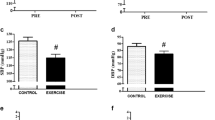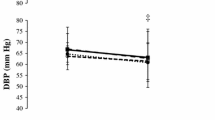Abstract
Syncope is widely reported following prolonged exercise. It is often assumed that the magnitude of exercise-induced hypotension (post-exercise hypotension; PEH), and the hypotensive response to postural change (initial orthostatic hypotension; IOH) are predictors of syncope post-exercise. The aim of this study was to determine the relationship between PEH, IOH, the residual IOH and syncope following prolonged exercise. Blood pressure (BP; Finometer) was measured continuously in 19 athletes (47 ± 20 years; BMI: 23.2 ± 2.2 kg m2; \( \dot{V} \)O2 max: 51.3 ± 10.8 mL kg−1 min−1) whilst supine and during head-up tilt (HUT) to 60° for 15 min (or to syncope), prior to and following 4 h of running at 70–80% maximal heart rate. Syncope developed in 15 of 19 athletes post-exercise [HUT-time completed, Pre: 14:39 (min:s) ± 0:55; Post: 5:59 ± 4:53; P < 0.01]. PEH was apparent (−7 ± 7 mmHg; −8 ± 8%), but was unrelated to HUT-time completed (r 2 = 0.09; P > 0.05). Although the magnitude of IOH was similar to post-exercise [−28 ± 12 vs. −20 ± 14% (pre-exercise); P > 0.05], the BP recovery following IOH was incomplete [−9 ± 9 vs. −1 ± 11 (pre-exercise); P < 0.05]; however, neither showed a relation to HUT-time completed (r 2 = 0.18, r 2 = 0.01; P > 0.05, respectively). Although an inability to maintain BP is a common feature of syncope post-exercise, the magnitude of PEH, IOH and residual IOH do not predict time to syncope. Practically, endurance athletes who present with greater hypotension are not necessarily at a greater risk of syncope than those who present with lesser reductions in BP.




Similar content being viewed by others
References
Brignole M, Croci F, Menozzi C, Solano A, Donateo P, Oddone D, Puggioni E, Lolli G (2002) Isometric arm counter-pressure maneuvers to abort impending vasovagal syncope. J Am Coll Cardiol 40:2053–2059
Chen CY, Bonham AC (2010) Post-exercise hypotension: central mechanisms. Exerc Sport Sci Rev 38:122–127
Davis JE, Fortney SM (1997) Effect of fluid ingestion on orthostatic responses following acute exercise. Int J Sports Med 18:174–178
Eysmann SB, Gervino E, Vatner DE, Katz SE, Decker L, Douglas PS (1996) Prolonged exercise alters beta-adrenergic responsiveness in healthy sedentary humans. J Appl Physiol 80:616–622
Franke WD, Johnson CP, Steinkamp JA, Wang R, Halliwill JR (2003) Cardiovascular and autonomic responses to lower body negative pressure: do not explain gender differences in orthostatic tolerance. Clin Auton Res 13:36–44
Gabbett TJ, Weston SB, Barrett RS, Gass GC (2001) Cardiovascular regulation during head-up tilt in healthy 20–30-year-old and 70–75-year-old men. Clin Sci (Lond) 100:199–206
Gratze G, Rudnicki R, Urban W, Mayer H, Schlogl A, Skrabal F (2005) Hemodynamic and autonomic changes induced by Ironman: prediction of competition time by blood pressure variability. J Appl Physiol 99:1728–1735
Gratze G, Mayer H, Skrabal F (2008) Sympathetic reserve, serum potassium, and orthostatic intolerance after endurance exercise and implications for neurocardiogenic syncope. Eur Heart J 29:1531–1541
Greenleaf JE, Convertino VA, Mangseth GR (1979) Plasma volume during stress in man: osmolality and red cell volume. J Appl Physiol 47:1031–1038
Halliwill JR (2001) Mechanisms and clinical implications of post-exercise hypotension in humans. Exerc Sport Sci Rev 29:65–70
Hart E, Dawson E, Rasmussen P, George K, Secher NH, Whyte G, Shave R (2006) Beta-adrenergic receptor desensitization in man: insight into post-exercise attenuation of cardiac function. J Physiol 577:717–725
Hiller WD, O’Toole ML, Fortess EE, Laird RH, Imbert PC, Sisk TD (1987) Medical and physiological considerations in triathlons. Am J Sports Med 15:164–167
Holtzhausen LM, Noakes TD (1995) The prevalence and significance of post-exercise (postural) hypotension in ultramarathon runners. Med Sci Sports Exerc 27:1595–1601
Holtzhausen LM, Noakes TD (1997) Collapsed ultraendurance athlete: proposed mechanisms and an approach to management. Clin J Sport Med 7:292–301
Holtzhausen LM, Noakes TD, Kroning B, de Klerk M, Roberts M, Emsley R (1994) Clinical and biochemical characteristics of collapsed ultra-marathon runners. Med Sci Sports Exerc 26:1095–1101
Imholz BP, Settels JJ, van der Meiracker AH, Wesseling KH, Wieling W (1990) Non-invasive continuous finger blood pressure measurement during orthostatic stress compared to intra-arterial pressure. Cardiovasc Res 24:214–221
James MA, Potter JF (1999) Orthostatic blood pressure changes and arterial baroreflex sensitivity in elderly subjects. Age Ageing 28:522–530
Kenney MJ, Seals DR (1993) Post-exercise hypotension key features, mechanisms, and clinical significance. Hypertension 22:653–664
Krediet CT, de Bruin IG, Ganzeboom KS, Linzer M, van Lieshout JJ, Wieling W (2005) Leg crossing, muscle tensing, squatting, and the crash position are effective against vasovagal reactions solely through increases in cardiac output. J Appl Physiol 99:1697–1703
Lucas SJ, Cotter JD, Murrell C, Wilson L, Anson JG, Gaze DC, George K, Ainslie PN (2008) Mechanisms of orthostatic intolerance following very prolonged exercise. J Appl Physiol 105:213–225
MacDonald JR (2002) Potential causes, mechanisms, and implications of post-exercise hypotension. J Hum Hypertens 16:225–236
MacDonald JR, MacDougall JD, Hogben CD (2000) The effects of exercise duration on post-exercise hypotension. J Hum Hypertens 14:125–129
Murrell C, Wilson L, Cotter JD, Lucas S, Ogoh S, George K, Ainslie PN (2007) Alterations in autonomic function and cerebral hemodynamics to orthostatic challenge following a mountain marathon. J Appl Physiol 103:88–96
Murrell CJ, Cotter JD, George KP, Shave R, Wilson LC, Thomas KN, Williams MJ, Lowe T, Ainslie PN (2009) Influence of age on syncope following prolonged exercise; differential responses but similar orthostatic intolerance. J Physiol 587:5959–5969
Rickards CA, Newman DG (2003) A comparative assessment of two techniques for investigating initial cardiovascular reflexes under acute orthostatic stress. Eur J Appl Physiol 90:449–457
Sawka MN, Burke LM, Eichner ER, Maughan RJ, Montain SJ, Stachenfeld NS (2007) American College of Sports Medicine position stand. Exercise and fluid replacement. Med Sci Sports Exerc 39:377–390
Scott JM, Esch BT, Lusina SJ, McKenzie DC, Koehle MS, Sheel AW, Warburton DE (2008) Post-exercise hypotension and cardiovascular responses to moderate orthostatic stress in endurance-trained males. Appl Physiol Nutr Metab 33:246–253
Seals DR (1989) Sympathetic neural discharge and vascular resistance during exercise in humans. J Appl Physiol 66:2472–2478
Smith JJ, Porth CM, Erickson M (1994) Hemodynamic response to the upright posture. J Clin Pharmacol 34:375–386
Sprangers RL, Veerman DP, Karemaker JM, Wieling W (1991a) Initial circulatory responses to changes in posture: influence of the angle and speed of tilt. Clin Physiol 11:211–220
Sprangers RL, Wesseling KH, Imholz AL, Imholz BP, Wieling W (1991b) Initial blood pressure fall on stand up and exercise explained by changes in total peripheral resistance. J Appl Physiol 70:523–530
Tanaka H, Sjoberg BJ, Thulesius O (1996) Cardiac output and blood pressure during active and passive standing. Clin Physiol 16:157–170
Thomas KN, Cotter JD, Galvin SD, Williams MJ, Willie CK, Ainslie PN (2009) Initial orthostatic hypotension is unrelated to orthostatic tolerance in healthy young subjects. J Appl Physiol 107:506–517
Toska K, Walloe L (2002) Dynamic time course of hemodynamic responses after passive head-up tilt and tilt back to supine position. J Appl Physiol 92:1671–1676
Van Lieshout JJ, Wieling W, Karemaker JM, Secher NH (2003) Syncope, cerebral perfusion, and oxygenation. J Appl Physiol 94:833–848
Wieling W, Krediet CT, van Dijk N, Linzer M, Tschakovsky ME (2007) Initial orthostatic hypotension: review of a forgotten condition. Clin Sci (Lond) 112:157–165
Acknowledgments
Funding for this study was provided by Sport and Recreation New Zealand (SPARC) and the Department of Physiology, University of Otago.
Conflict of interest
The authors declare no conflict of interest.
Author information
Authors and Affiliations
Corresponding author
Additional information
Communicated by Dag Linnarsson.
Rights and permissions
About this article
Cite this article
Murrell, C.J., Cotter, J.D., George, K. et al. Syncope is unrelated to supine and postural hypotension following prolonged exercise. Eur J Appl Physiol 111, 469–476 (2011). https://doi.org/10.1007/s00421-010-1671-8
Accepted:
Published:
Issue Date:
DOI: https://doi.org/10.1007/s00421-010-1671-8




